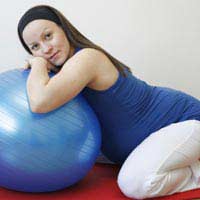What Positions Are Best for Labour?

Lying down on a bed during labour is the position that tends be viewed as standard. Whilst it certainly does have its benefits, there are other positions that can be beneficial too, for both mum and baby. Here we explore some of the positions that can be good for labour and help you deal with contractions.
Rather than simply lying down all through labour, it can be good to try out different positions, both when labour first starts and you’re feeling restless, and as it progresses. Where possible, your midwife should encourage an active labour and suggest different positions that may help you. However much you may feel uncomfortable and unsure that moving would make you feel better, they do know what they’re talking about and it’s beneficial to at least try out their suggestions.
Some positions are particularly good for your baby, helping labour progress further and ensuring both you and your baby cope well with the situation. Depending on the stage of labour you’re in, then you may need help changing position. Unfortunately, if you’ve had an epidural, then changing position may not be possible.
Standing Up
Standing up works well for some women and is a position that can easily be tried out. It can help reduce the amount of pain that your contractions produce, especially if you gently rock your hips back and forwards, or in a circular movement, and can help you feel slightly more in control. Being upright instead of lying down can also help your baby’s head to move down onto the neck of the womb, helping the cervix dilate, which is important for the progression of labour.It’s also a good position for your partner to help and support you, as they will be able to easily massage your back. You don’t necessarily have to be standing up straight – you could try leaning onto the back of a sturdy chair or sofa, lean onto the bed if you’re in a delivery room (and the height of the bed can be adjusted to your height) or lean onto your partner.
Kneeling On All Fours
It may not sound very elegant, but when you’re in the full throes of labour, you won’t care! Kneeling down on all fours, with pillows, cushions or blankets under your knees and hands, is a great position for taking the weight off your back. It’s also good for your baby too, as it can help your baby get into a better position, ready for the birth.If you feel that your head, arms and shoulders need a bit more support, then try leaning onto a birthing ball, rather than the floor. This can be useful for helping you keep up gently rocking movements when the contractions take hold. Some women take so well to this position that they remain in it to give birth (sometimes this position can be adopted on the bed too). In fact, it’s a good birth position for both mum and baby and can reduce the risk of tearing.








